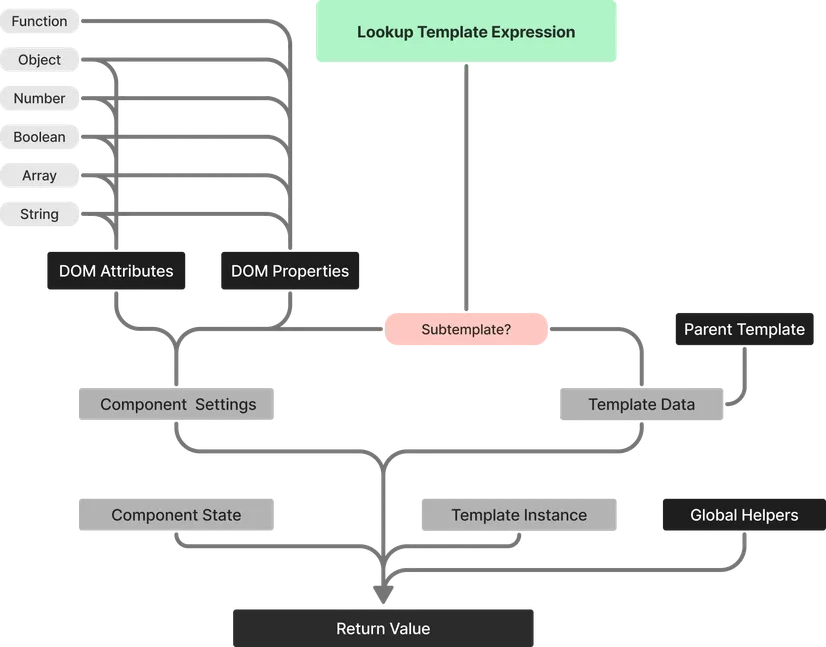Enter a search term above to see results...
On This Page
Templates & Data Context
Rendering HTML
Your component’s HTML structure is defined by a template and a data context to generate your component’s HTML.
Comparing to React Instead of using a
render()function to returnjsx, each component’s template provides the high-level logic for explaining how HTML should be rendered from data for your component and will automatically re-render sections of a template depending on the reactivity of the data.
Templates
Your template defines how your component’s HTML is rendered:
- Conditionals - Branching structures like
ifelse ifandelse - Looping structures - Structures to iterate through data like arrays or objects
- Reactive data - State stored with your component that should update the page when it updates
- Function calls - Methods on your component that allow you to access content and perform tasks
- Subtemplates - Reusable pieces of HTML organized as a separate file
- Slots - Locations where content can be placed inside your component
- Snippets - Reusable HTML structures inside a component
For more information see templates.
Data Context
The template’s data context is a combination of several data sources that are looked up in sequence.
For instance, our template might include something like:
Greetings, {name}This will check for name in each of these locations and then return the first available defined value:
- Component Instance - A value or function on your component called
name - Settings - A value
namepassed in via HTML attribute or property - State - An internal reactive state called
name - Subtemplate Data - Data passed in from a parent template called
name - Global Helpers - A global helper registered across templates called
name
Simplified Data Structures - The data context is flat, making it easy to move values between
property,state, andsettingswithout modifying templates.
Settings
For comprehensive details on settings, see the dedicated Settings documentation.
Settings are values which you want users of your component to be able to modify. They provide a way to customize component behavior without modifying the component’s internal code.
const defaultSettings = { name: 'Jack', color: 'blue'};
defineComponent({ tagName: 'name-card', defaultSettings});You can override settings through HTML attributes or DOM properties:
<name-card name="Sally" color="red"></name-card>const el = document.querySelector('name-card');el.name = 'Sam';State
For comprehensive details on state management, see the dedicated State documentation.
State is a data store that uses Signals to recompute references to a value when its underlying value is modified. State represents the internal, changing data of your component.
const defaultState = { counter: 0, isActive: false};
defineComponent({ tagName: 'interactive-component', defaultState});State can be accessed and modified inside component methods and automatically updates your UI:
const createComponent = ({self, state}) => ({ incrementCounter() { state.counter.value += 1; }});In templates, state values can be accessed directly by name:
Counter value: {counter}Instance
Your component instance stores methods and properties that implement the functionality of your component. These can be accessed from various locations:
Accessing in Templates
Any method or property declared in createComponent can be accessed directly from your template:
const createComponent = ({self, state}) => ({ getAge(user) { return Math.floor((new Date() - new Date(user.born_date)) / 31557600000); }});{getAge user}Accessing Internally
You can access your template instance as self, component, or tpl from other callbacks:
const onRendered = ({ self }) => { self.incrementCounter();};Accessing Externally
You can also access your component instance directly from the DOM:
const { component } = document.querySelector('ui-counter');component.incrementCounter();Subtemplates
For comprehensive details on subtemplates, see the dedicated Subtemplates documentation.
SUI components can either be rendered to a tagname as a web component or exported to be used as subtemplates in other components. This is dependent on whether tagName is specified.
When no tag name is specified, they are returned as Subtemplates which can be passed in to other components.
When components are rendered as subtemplates, their data context is defined explicitly from the parent template.
Subtemplate Example
Global Helpers
Global helpers are utilities available in all templates and provide classMap, formatDate, concat, stringify to format values for output.
For a list of global helpers please visit the dedicated global helper page in templating.
Helper Example
In this example, formatDate is used to format the display of a date set in the component’s state.
{formatDate currentTime 'h:mm:ss a'}Order of Data Lookups
For a complete picture of how an expression is looked up from inside your template’s data context, please refer to the following chart:
